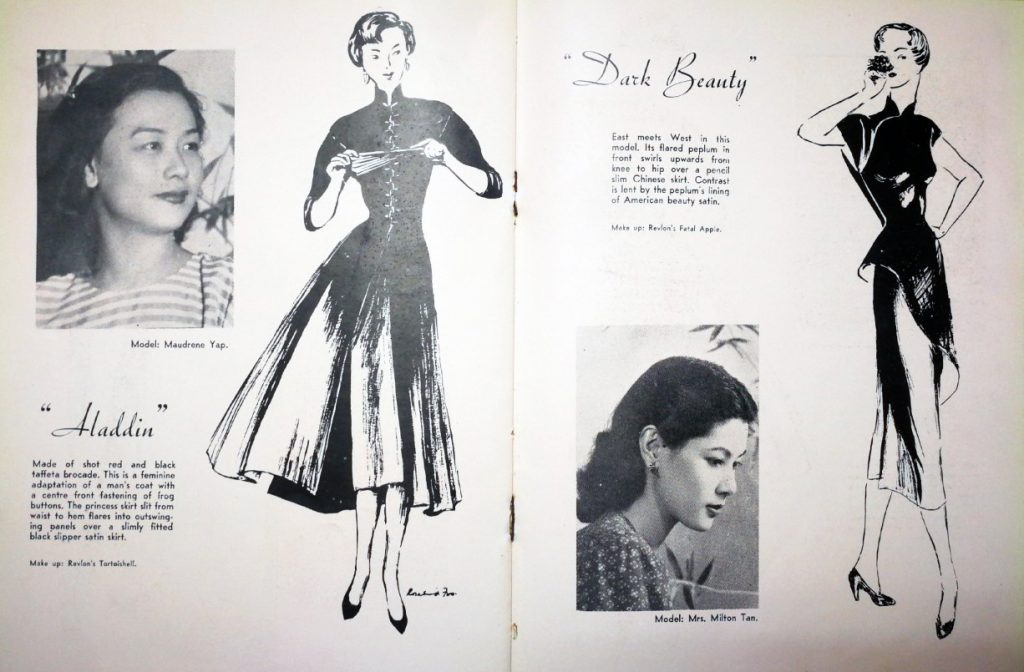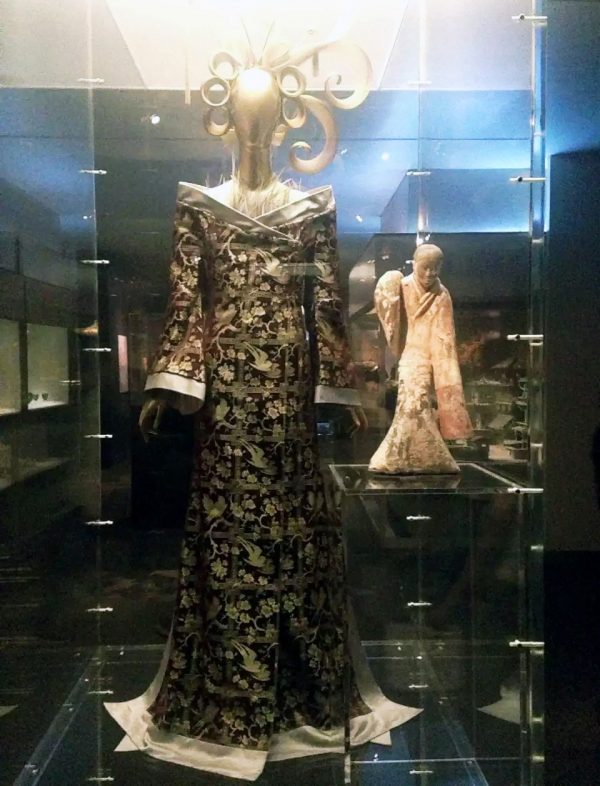Establishing fashion history in Singapore

Figure 1: ‘A festival of Chinese fashions, presented by Singapore Chinese Ladies Association’ by the Singapore Chinese Ladies Association (1949)
Fashion studies and fashion history are disciplines that have not been treated seriously in academia. Perceived as frivolous, with an air of vanity and class privilege, fashion as a subject of study has traditionally been treated with a certain degree of contempt in both academia and museum sectors.
Such attitudes are however, slowly changing. With a shift of attention from politico-economic history to cultural history, from macro narratives of important men and events to the “softer” side of history on ordinary people and their quotidian lives, the mundane question of how people dress starts to assume academic significance among scholars of various social sciences and humanities disciplines.
In North American and European institutions, fashion studies are now established multi-disciplinary subjects that integrate history, anthropology, media communication and art and design.
Following this academic shift, the museum sector is also witnessing a sea change in its scope of exhibition. A series of high-profile retrospective fashion exhibitions in the world-renowned
Metropolitan Museum of Art (MMA) in New York City and the Victoria and Albert Museum
(V&A) in London brought high fashion within arms’ reach of the public.
The annual exhibition of the Costume Institute of the MMA, organised around a central theme each year and officially opened by the highly publicized Met Gala- hailed as the Superball event of the fashion and celebrity worlds-, repeatedly breaks its own records of visitors from around the world. Some notable exhibitions include “Alexander McQueen: Savage Beauty” in 2011 which later travelled to the V&A in 2015, and “China Through the Looking Glass” at the MMA in 2015.

Figure 2: A dress by Alexander McQueen (British, 1969-2010) is juxtaposed with a Han Dynasty (206 BCE - 220 CE) figurine to invoke the inspirational linkages. China Through the Looking Glass, Metropolitan Museum of Art, New York City. 2015. Photo courtesy of author.
Undeniably more accessible than fine art, fashion’s appeal is built on a quotidian basis and is therefore more relatable to ordinary people’s lives. People who are socially and economically excluded from the loftiness of high art are now willing to step into the gatekeepers of civilization and culture to experience the fusion of art and fashion first hand. Set against the backdrop of artistic and historical masterpieces, the glamor and extravagance of the garments on display physically closes the gulf between high art and high fashion, elevating visitors’ sensory experience to a new level.
This trend of fashion exhibitions in cultural institutions has been copied by other smaller museums in North America to bring in extra revenue, and travels also across the Pacific to Asia. Singapore’s very own Asian Civilization Museum (ACM) mounted a first-of-its kind exhibition “Guo Pei: Chinese Art and Couture” in 2019, which married contemporary Chinese couture designs with Peranakan bridal costumes and the ACM’s own Chinese art collection.

Figures 3 and 4: ‘Guo Pei: Chinese Art and Couture’: examples of the linkages between traditional Chinese dress, Peranakan wedding costume, and contemporary Chinese couture design. Photos by Clair Hurford.
However, unlike higher education institutions in the West, Singapore does not have a fashion studies discipline to back up such novel curatorial undertaking. While the fashion programs at LASALLE College of the Arts and Nanyang Academy of Fine Art (NAFA) are training grounds for aspiring young people for the local fashion business, these vocational programs do not have, and do not see the need for an academic research branch, other than perhaps to market the business side of things.
One may also question if and when was there fashion history in Singapore? Did we have local fashion designers? Was there even a fashion industry in Singapore? The answer is yes, yes, and yes. But it has been overlooked and seriously understudied, despite the rich materials available for research.
The considerations and calculations that go into the decision of the day’s outfit say much about individuals and their socio-economic status and identities, both real and imagined. How have Singaporeans responded to foreign trends, from the West and the East? How have these trends been domesticated to evolve into something local? How have local creative talents struggled to find their voice and niche in the intense market competition? And how did fashion and sartorial practices reflect Singapore’s societal structure over time?
Answers to these questions offer new perspectives on ongoing debates about Singapore’s identity and place in the world. In other words, sartorial traditions and their changes over time—expressed and understood as fashion—are capable of telling fascinating stories at both the macro and micro levels.
As a historian, my work is the excavation of such stories, which I use to illuminate the socio-cultural issues of twentieth century Singapore. From Singapore’s transformation as a colonial entrepôt into a precarious independence and the present cosmopolitan city-state, fashion has functioned as a site of transformation, serving as both a witness and an interlocutor to the city’s modernisation and urbanisation.
Taking fashion as a multidimensional phenomenon, a multi-sited approach is designed to tackle the various aspects of fashion. They include fashion shows, fashion media, fashion schools, and departmental stores and boutiques.
Together, the research aims to produce a coherent narrative of Singapore fashion history of the twentieth century, having important implications for its urban heritage, as well as bearing informative value to the city’s future endeavour as a fashion and creative hub of the region.
My two years at ARI has allowed me to begin initial archival research in Singapore and to undertake funded field trips to Malacca, Penang, and Kuala Lumpur. Primary source materials on Singapore fashion history include digital archives of newspaper and photographs, rare collection of magazines and pamphlets, as well as material artefacts in museums.
Research trips to Malaysia have allowed to me comparatively study the Peranakan material culture of fashion and its respective state of preservation, collection, and representation. This study culminates in a research paper to be collected in a forthcoming book titled Rethinking Fashion Globalization, published by Bloomsbury Academic, London.
I have also presented my research results at multiple international conferences, and received favourable feedback. In particular, fashion historians and scholars from around the world welcome the study on Singapore, considering the long-awaited delay in adding the diaspora Chinese communities of Southeast Asia into the fashion discourse of non-Western fashion cultures.
However, locally, there remains much work to be done. In the past two years, I have been mainly performing solo show digging into the rich history of Singapore’s sartorial and fashion histories. The job is rewarding, but also very lonely. There is virtually a vacuum in local academia, which remains stubbornly traditional in structural terms, as shown, for instance, through the tendency to fund projects with apparent higher socio-economic impact factor headed by established professors.
To garner support and to call attention to this promising field of study, I have therefore reached out to sectors outside academia, and, overtime, have managed to establish a research network on Singapore fashion history/studies comprising a librarian at the National Library, museum curators, textile scholar and collector, a former fashion journalist-turned-cultural studies PhD candidate, as well as academics working tangentially on the subject. My goal is to pool our respective expertise to advance the serious scholarly study of fashion in Singapore.
Our combined efforts recently paid off in the form of a research grant awarded by the National Heritage Board. The project aims to identify and document a yet-to-be acknowledged aspect of the Singapore history—fashion shows and fashion media—as part of the nation’s larger cultural heritage worth remembering.
Due to the still pervasive perception of fashion as a less than serious academic pursuit, many historical records have failed to survive and are forever lost with the passage of time. The first phase in our project is to establish a database of relevant materials of all mediums—textual, visual, and actual physical objects—so that we can (re)construct an empirical foundation for the fashion history of Singapore.
If you are reading this, and you happen to know someone who possess materials pertinent to our project, or if you have been an insider or participant of the fashion scene in Singapore’s yesteryears please join us in our collective effort to establish the field of fashion history in Singapore.






